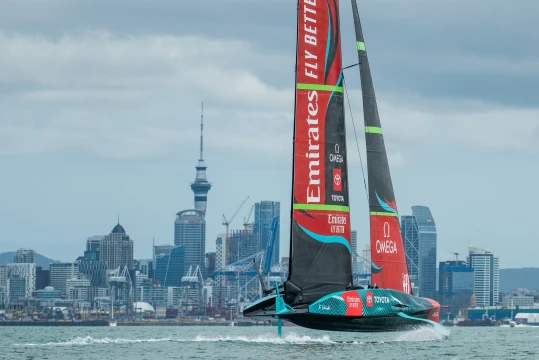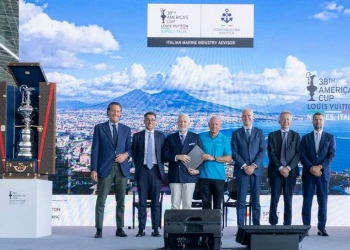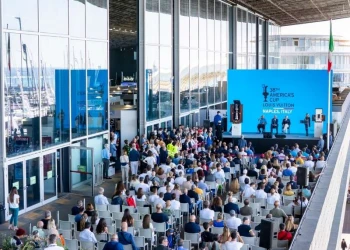
© Adam Mustill / America's Cup
ETNZ Te Rehutai returns to the Hauraki Gulf
The Defenders of the America’s Cup on behalf of the Royal New Zealand Yacht Squadron, re-launched Te Rehutai, their all-conquering boat from AC36 in a new livery and with huge changes all over whilst welcoming onboard elite cycling athletes that have undergone extensive testing to join the team.
There was almost a ‘first day at school’ feel dockside as Te Rehutai splashed. The smiles on the crew member’s faces masked an apprehension but belied the excitement at getting the most powerful America’s Cup yacht (to date) back on the water and back into commission.
For many it was their first time on AC75, but Emirates Team New Zealand is staffed equally with apex sailors of long Cup experience. Nathan Outteridge, the alternate helm with Pete Burling was one of those jumping onboard for the first time and he was enthused saying: “Yeah it was really cool. Obviously, I watched the boat sail around a lot a few years ago and had heaps of sailing on the AC40 lately, but nothing really compares to these beasts. They’re so big and so powerful and…fortunately for me it wasn't very windy, so it was nice to sort of ease into it. The boats are still amazing how fast they go for such little wind and just the power of these boats is something that I haven't experienced for a long time.”
Te Rehutai docked out for its commissioning sail at 11.25am and once the double-skinned mainsail was attached, hoisted, tweaked and set with the lower battening, we got a first glimpse of the new trench arrangement with five pods on either side containing the following: In the aft two pods, the cyclors are housed, tucked in a super aero position with just the arches of their backs exposed above the pod-line. Immediately forward of the cyclors are the Flight Controllers – today it was Nick Burridge in the starboard pod and Blair Tuke in the port pod. Then come the helmsmen (Burling and Outteridge) sandwiched in a brilliant communications loop with their Trimmers (Josh Junior and Andy Maloney) in the furthest pod forward.

So, in total, Te Rehutai is sailing in its current configuration with ten sailors onboard. For AC37 in Barcelona this will be reduced to eight under the current rule so presumably at some point the role of Trimmer and Flight Controller will need to be combined – or will Emirates Team New Zealand, the great innovators of the America’s Cup, come up with another solution?
Much work has been done on the mast set-up by the Kiwis to both strengthen it for the lack of running backstays and develop their thinking further at the mast ball area. The mast rotation controls were still above deck as we saw in AC36 and at the clew area of the mainsail, the mast rams were hidden by a huge blocking plate of cloth that extended far beyond the leech line. The ram itself along the deck appeared relatively standard whilst the leech tensioner was attached the traveller by a doubled strop. As we have seen with the LEQ12 of the Kiwis, much attention has been paid to the sail controls and the AC75 mainsail was topped out at the head with a straight batten closing the double skins and a lot of time was spent on adjusting the Cunningham control. Whilst sailing, and even whilst stopped, huge creases could be seen filtering down to the mainsail tack, indicating quite extreme tensioning. One to watch from a recon perspective for sure.
The Kiwis had a relatively light session today with five gybes, four foiling, and a tack that ended in displacement as the light breeze only offered really the chance for a shakedown sail. The coming days will see Te Rehutai stretched and at full kilter.
Nathan Outteridge, always terrific and open in interview gave a enthusiastic summary of the day that is worth recording here. Talking about the programme he said: “All the same principles apply, you know you've still got this three foil foiling monohull and all the twin skin main stuff all applies but it's just the scale and it's just the loads. You get used to looking at main loads of down at 3 tons or whatever and you’re well above that now…when you're pulling stuff on, you can hear, you can feel the load, you can feel the power of these boats and that's something that you probably don't get at all in the AC40s or any other boat that I've sailed. It's an incredibly complicated boat as well and so I think it’s a really good decision to bring the old girl back out with a bunch of changes on it and keep pushing the development of the systems and for me personally I think going straight from an AC40 into one of these is a huge jump so I'm glad I've had a good few months under my belt.”

With new team members onboard, Nathan commented: “I think it's fantastic we've got all the sailing team now out on the water. A lot of the guys have been training for 6-9 months probably even two years since the last America's Cup, maintaining fitness and getting ready for today essentially. And a lot of our sailing (so far) has been just the four of us going out and it was great to go through the two boating and get more sailing team members on the water, but this is the real deal, this is getting all the cyclors involved learning about the whole hydraulic system that's going to be a huge part moving forward. There's been quite a few rule changes on how all the systems work and so yeah this is…a perfect testing boat for us to just keep that development happening.”
The coming weeks and months are going to be fascinating. Emirates Team New Zealand joins Alinghi Red Bull Racing and New York Yacht Club American Magic in re-commissioning highly modified boats from AC36 and testing at full scale. It’s an interesting move. Is it the move that gaps them from the other teams in this America’s Cup cycle? Only time will tell.






